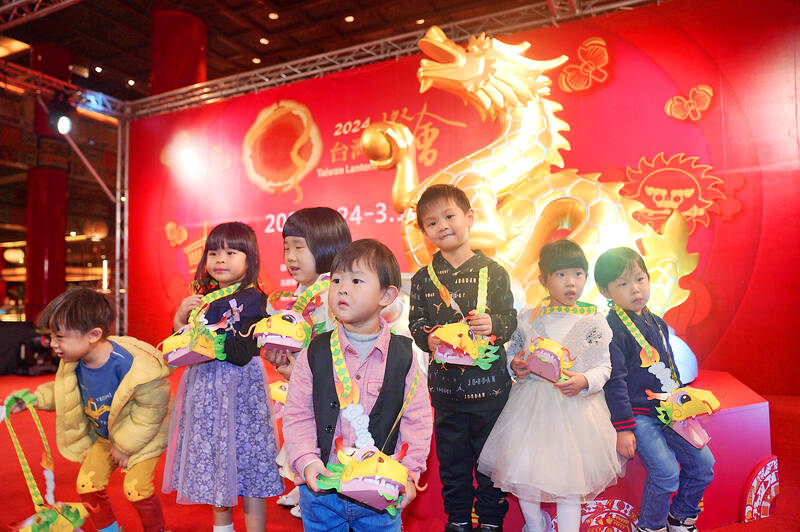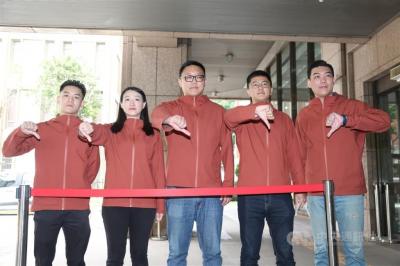The Tourism Administration yesterday in a ceremony in the Grand Hotel Taipei unveiled the designs of the main lantern and handheld lanterns of this year’s Taiwan Lantern Festival.
The annual festival is to open in Tainan on Feb. 24 and end on March 10.
The 22m-high main lantern, named Dragon Comes to Taiwan (龍來台灣), features a golden dragon made of carbon 60 and recycled ethylene-vinyl acetate (EVA) film, the administration said.

Photo: Taipei Times
EVA film is an encapsulation material used in solar panels.
The main lantern’s design was inspired by the flying dragons wrapping around the two stone pillars at the entrance to Tainan Grand Matzu Temple’s (台南大天后宮) court, JFA Artwork Project Design Co project director Camay Peng (彭力真)said.
The festival is also to give away small handheld lanterns to its visitors. The small lanterns are called Small Dragon Bags (小龍包), pronounced same as steamed dumplings in Mandarin.

Photo: CNA
Artist Lin Chia-wei (林佳葦), who designed Small Dragon Bags, said that the lanterns feature the head of a more friendly-looking dragon, which can be opened at the back for children to store small toys.
People can carry them like a handbag or hang them on their necks, Lin said.
Minister of Transportation and Communications Wang Kwo-tsai (王國材) said this would be the second time that Tainan hosted the Taiwan Lantern Festival, which was held in the city in 2008.
“The festival this year is significant as it is held for the first time following the merger of the Tainan City and county. It is also held after the Tourism Bureau was upgraded to the Tourism Administration in September last year,” Wang told the participants of the ceremony.
“The main lantern’s name, Dragon Comes to Taiwan, sounds like ‘All comes to Taiwan’ in Hoklo [commonly known as Taiwanese]. We hope the festival would attract visitors from different places, making it an international tourism event,” Wang said.
Tainan Mayor Huang Wei-che (黃偉哲) said Tainan is to celebrate the 400th anniversary of the city’s establishment in 1624, as he urged people to join the festival.
“We were not around when the city had its 300th anniversary, and we are not going to be around when it celebrates the 500th anniversary. So we should not miss this milestone,” Huang said.
Visitors in Tainan can see various types of orchids in the Taiwan International Orchid Show during the day and watch lanterns at the festival at night, Huang said.
The Yanshui Beehive Fireworks Festival (鹽水蜂炮) is to be held on Feb. 23 and Feb. 24 at Wu Temple (武廟) in the city’s Yenshui District (鹽水), he added.

Taiwan is stepping up plans to create self-sufficient supply chains for combat drones and increase foreign orders from the US to counter China’s numerical superiority, a defense official said on Saturday. Commenting on condition of anonymity, the official said the nation’s armed forces are in agreement with US Admiral Samuel Paparo’s assessment that Taiwan’s military must be prepared to turn the nation’s waters into a “hellscape” for the Chinese People’s Liberation Army (PLA). Paparo, the commander of the US Indo-Pacific Command, reiterated the concept during a Congressional hearing in Washington on Wednesday. He first coined the term in a security conference last

Prosecutors today declined to say who was questioned regarding alleged forgery on petitions to recall Democratic Progressive Party (DPP) legislators, after Chinese-language media earlier reported that members of the Chinese Nationalist Party (KMT) Youth League were brought in for questioning. The Ministry of Justice Investigation Bureau confirmed that two people had been questioned, but did not disclose any further information about the ongoing investigation. KMT Youth League members Lee Hsiao-liang (李孝亮) and Liu Szu-yin (劉思吟) — who are leading the effort to recall DPP caucus chief executive Rosalia Wu (吳思瑤) and Legislator Wu Pei-yi (吳沛憶) — both posted on Facebook saying: “I

Sung Chien-liang (宋建樑), who led efforts to recall Democratic Progressive Party (DPP) Legislator Lee Kun-cheng (李坤城), was released on bail of NT$80,000 today amid outcry over his decision to wear a Nazi armband to questioning the night before. Sung arrived at the New Taipei District Prosecutors’ Office for questioning in a recall petition forgery case last night wearing a red armband bearing a swastika, carrying a copy of Adolf Hitler’s Mein Kampf and giving a Nazi salute. Sung left the building at 1:15am without the armband and covering the book with his coat. Lee said today that this is a serious

The Ministry of Economic Affairs has fined Taobao NT$1.2 million (US$36,912) for advertisements that exceed its approved business scope, requiring the Chinese e-commerce platform to make corrections in the first half of this year or its license may be revoked. Lawmakers have called for stricter enforcement of Chinese e-commerce platforms and measures to prevent China from laundering its goods through Taiwan in response to US President Donald Trump’s heavy tariffs on China. The Legislative Yuan’s Finance Committee met today to discuss policies to prevent China from dumping goods in Taiwan, inviting government agencies to report. Democratic Progressive Party Legislator Kuo Kuo-wen (郭國文) said